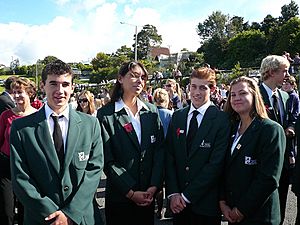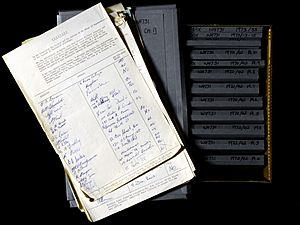Education in New Zealand facts for kids
| Ministry of Education / Te Tāhuhu o Te Mātauranga | |
|---|---|
| Minister of Education | Chris Hipkins |
| National education budget (2014/15) | |
| Budget | NZ$13,183 million |
| General details | |
| Primary languages | English, Māori |
| System type | Decentralised national |
| Enrollment (July 2011) | |
| Total | 762,683 |
| Primary | 475,797 |
| Secondary | 286,886 |
| Attainment (2015) | |
| Secondary diploma | 88% |
New Zealand's education system helps students learn from primary school all the way through to university. The school year usually starts in early February and finishes in mid-December for primary schools. Secondary schools and universities have slightly different dates.
In 2009, an international study called PISA (Programme for International Student Assessment) ranked New Zealand very highly. It was 7th best in the world for science and reading, and 13th for maths. The UN's Human Development Index also often ranks New Zealand's education system among the best globally.
Contents
History of Education in New Zealand
Before Europeans arrived, Māori had their own ways of teaching. They used wānanga, which were like schools, to share traditional knowledge. This included songs, tribal history, and how to use medicinal plants. Elders called tohunga usually led these teachings.
Formal European-style schooling began in 1815. Missionaries from the London Missionary Society set up the first schools in the Bay of Islands. They learned Māori and taught both children and adults. The main learning tools were the Christian New Testament and slates. Teaching was done in Māori.
By 1860, many Māori could read and write in their own language. For a long time, teaching in Māori continued. However, after 1900, there was a push to teach Māori children in English. This was partly to help them fit into New Zealand society.
New Zealand created its official state education system in 1877. Before this, most secondary schools were private or "Grammar Schools." Auckland Grammar School was one of the first, starting in 1850.
Primary and Secondary Schooling

All New Zealand citizens can get free primary and secondary schooling. This starts from their 5th birthday until the end of the year they turn 19. School is compulsory for students between ages 6 and 16. Most students start school at age 5 and stay until at least age 17.
Families can also choose to teach their children at home. They need to show the Ministry of Education that their child will learn just as well as in a regular school.
There are three main types of schools in New Zealand:
- State schools: These are public schools, funded by the government. Most students (about 85%) go to these schools.
- State-integrated schools: These used to be private schools, often faith-based, that joined the state system. They get government funding but can charge fees.
- Private schools: These schools are independent and rely on fees paid by parents. About 3.6% of students attend private schools.
School Year Levels
New Zealand schools use 13 academic year levels, from Year 1 to Year 13. Students usually start school in Year 1 if they turn five early in the school year. If they turn five later, they might start in Year 0.
Primary education lasts for eight years (Years 0–8). Students then move on to secondary education, also called high school or college. This lasts for five years (Years 9–13).
| Year | Age at start of school year | Age at end of school year |
|---|---|---|
| 0 | 4-5 | 5-6 |
| 1 | 4–5 | 5–6 |
| 2 | 5–6 | 6–7 |
| 3 | 6–7 | 7–8 |
| 4 | 7–8 | 8–9 |
| 5 | 8–9 | 9–10 |
| 6 | 9–10 | 10–11 |
| 7 | 10–11 | 11–12 |
| 8 | 11–12 | 12–13 |
| 9 | 12–13 | 13–14 |
| 10 | 13–14 | 14–15 |
| 11 | 14–15 | 15–16 |
| 12 | 15–16 | 16–17 |
| 13 | 16–17 | 17–18 |
What Students Learn and How They Qualify
Most schools follow a national curriculum. English-speaking schools use The New Zealand Curriculum (NZC). Māori-speaking schools use Te Marautanga o Aotearoa (TMoA). Private schools have their own curricula, but they must be similar to the national ones.
The New Zealand Curriculum covers eight main learning areas. These include English, maths, science, arts, and social sciences. Te Marautanga o Aotearoa also includes Māori language.
The main qualification for secondary school students is the National Certificate of Educational Achievement (NCEA). Some schools also offer international qualifications like Cambridge International Examinations (CIE) or the International Baccalaureate (IB).
Different Kinds of Schools
New Zealand has different types of schools based on how they are funded and the age groups they teach.
State Schools
State schools are free for New Zealand citizens. However, parents usually pay for things like stationery, uniforms, and school trips. Schools might also ask for donations to help with extra costs. Each state school is run by a Board of Trustees, which includes parents, staff, and the principal.
State-Integrated Schools
State-integrated schools are former private schools that joined the state system. They keep their "special character," often being linked to a religious group. Most of these are Catholic schools. Parents pay "attendance dues" to help maintain the school buildings.
Private Schools
Private schools are not funded by the government. They rely on fees paid by parents, which can be quite high. A small number of students attend private schools.
Other Schooling Options
Parents can choose to home-school their children. They receive some money from the government to help with costs. There are also "area schools" in smaller towns that teach students from Year 1 to Year 13.
Māori Language in Education
While English is the main language in New Zealand schools, there's been a big effort to teach more in Māori. Before Europeans, Māori learned everything in their own language.
In the early 1900s, schools even discouraged speaking Māori. This led to many Māori losing their language. By 1960, only 25% of Māori could speak it.
In the 1970s and 80s, groups like Ngā Tamatoa fought to bring Māori language back into schools. This led to the creation of kōhanga reo (Māori language preschools) in 1981 and Kura Kaupapa Māori (full immersion Māori schools) in 1985.
Today, Māori language education is available in many places. Students can learn Māori as a subject or attend full immersion schools.
| Māori Medium (mostly Māori language) | Māori Language in English Medium (some Māori language) | No Māori Language in Education | Total | |||||||
|---|---|---|---|---|---|---|---|---|---|---|
| Enrolment July 2012 | % Enrolled | Change from July 2004 | Enrolment July 2012 | % Enrolled | Change from July 2004 | Enrolment July 2012 | % Enrolled | Change from July 2004 | Enrolment July 2012 | |
| Māori students | 16,353 | 9.45% | –7.26% | 52,655 | 30.43% | –5.81% | 104,003 | 60.11% | 19.27% | 173,011 |
| Non-Māori students | 439 | 0.07% | 43.00% | 88,290 | 15.04% | –4.24% | 498,220 | 84.88% | –2.58% | 586,949 |
| All students | 16,792 | 2.21% | –6.40% | 140,945 | 18.55% | –4.83% | 602,223 | 79.24% | 0.60% | 759,960 |
School Timetable
The school day usually starts between 8:00 and 9:00 am and finishes around 3:00 pm. The school year runs from late January to mid-December. There's a six-week summer holiday in December and January.
The year is divided into four terms, each lasting about ten weeks. There are two-week breaks between terms.
How Education is Funded
Primary and Secondary School Funding
The New Zealand Government gives money to state and state-integrated schools for their running costs. Smaller schools get extra funding. Schools in poorer areas (low-decile schools) also receive more money.
Schools often ask for voluntary donations from parents. These "school fees" help cover extra expenses not fully paid for by the government. Parents also typically pay for uniforms, trips, and stationery.
State-integrated schools also charge "attendance dues." These are compulsory fees paid to the school owners to help maintain buildings.
Private schools mainly rely on tuition fees from parents. They do receive some government funding, but it's much less than state schools.
Teacher salaries in state and state-integrated schools are paid directly by the Ministry of Education. Salaries are the same nationwide and depend on a teacher's qualifications and experience.
Students with special needs can get extra funding called Ongoing Resource Scheme (ORS). This helps pay for teacher aides, specialists, and special equipment.
University and College Funding
Funding for universities and polytechnics comes from government money and student fees. The government pays a grant for each student enrolled in approved courses.
Students can get Student Loans and Student Allowances to help pay for fees and living costs.
Student Allowances
Student Allowances are grants that students don't have to pay back. They are for students who need financial help. The amount depends on things like age, where they live, and their family's income.
Student Loans
The Student Loan Scheme is available to all New Zealand citizens. It covers course fees, course-related expenses, and a weekly living allowance. The loan must be paid back once the student starts earning money.
Since April 2006, students living in New Zealand do not have to pay interest on their student loans. This helps make education more affordable.
Changes in School Standards
In 1995, New Zealand students ranked 18th out of 24 countries in an international maths and science survey (TIMSS). This caused concern, and new teaching methods were introduced. However, New Zealand's ranking dropped even further in later years.
In 2012, the TIMSS survey found New Zealand 9-year-olds ranked 34th out of 53 countries in maths. Experts like Sir Vaughan Jones, a famous New Zealand mathematician, believe children need to learn basic arithmetic very well before moving on to harder problem-solving.
A different report in 2012, The Learning Curve, ranked New Zealand 8th out of 40 countries overall. This report highlighted that good teaching and a culture that values learning are key to a successful education system. It noted that countries like Hong Kong and Japan, which ranked higher, have societies where education is highly important.
Māori and Pacific Island Student Achievement
New Zealand aims to improve the academic success of its Māori and Pacific Island students. In 2013, the PISA international standard showed that while Pākehā (New Zealanders of European descent) students ranked very high, Māori students were 34th and Pacific students were 44th. Efforts are ongoing to close this gap.
School Bullying
Bullying is a problem in New Zealand schools. In 2007, one in five high school students reported being cyber-bullied. An international study in 2009 found New Zealand had one of the highest rates of physical bullying among the countries surveyed.
In 2009, the Ombudsman investigated school bullying after some serious incidents. The Ombudsman's report suggested that schools should have compulsory anti-bullying programs. The Government has put money into a "Positive Behaviour for Learning" plan to help schools deal with bullying.
Images for kids
-
New Zealand college students at an Anzac Day parade in Auckland.




